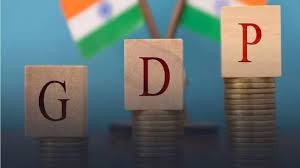Economic Engine
India is witnessing a significant shift in the global power hierarchy by standing tall, with its economic growth, strategic location, and democratic values making it a player to be reckoned with. India’s economic rise is undeniable.
As recently as May 2024, India surpassed the United Kingdom to become the world’s fifth-largest economy. India’s economic performance has been a subject of much discussion in recent times and this achievement was acknowledged by world leaders, with United States President Joe Biden stating, “India’s economic rise presents a tremendous opportunity, not just for the Indian people, but for the entire world”.

The Growth Story
India has witnessed a remarkable rise in its Gross Domestic Product (GDP) in the fiscal year 2023-24 (FY24). The Indian economy is estimated to have grown by a solid 8.2% in FY24, according to the Ministry of Statistics and Programme Implementation. This growth surpasses the 7% recorded in FY23 and puts India at the forefront of major economies globally. The International Monetary Fund (IMF) projects India to remain the world’s fastest-growing major economy in 2024 and 2025, surpassing China.
This growth is fueled by a young population, a rising domestic market, and a growing services sector. This economic power is translating to a global influence.
Drivers of the Growth
Several factors have contributed to India’s recent GDP surge. Few of which are,
- Manufacturing Revival: The manufacturing sector, which contracted in FY23, witnessed a significant turnaround in FY24, registering a growth of 9.9%. This revival can be attributed to initiatives like “Make in India,” which aims to boost domestic manufacturing and attract foreign investment.
- Favorable Export Environment: India’s exports have played a crucial role in its economic growth. While the share of exports in GDP registered a marginal decline in Q3 FY24, it still remains a significant contributor. The growing global demand for Indian goods, especially in sectors like pharmaceuticals and information technology, is a positive factor.
- Government Spending: The Indian government’s increased spending on infrastructure projects and social welfare programs also played a role. This spending injects money into the economy, stimulating production and creating jobs. However, it’s important to note that high government spending can also contribute to inflation if not managed effectively.
Impact of the growth
The growth in key sectors like manufacturing and construction has the potential to generate significant employment opportunities, particularly for skilled workers and a higher GDP leads to increased government revenue, which can be used for critical social and infrastructure development projects.
India’s strong economic performance has bolstered its global standing. This can lead to increased foreign investment and trade opportunities. Further bringing in, not only capital but also technology and expertise, fueling economic growth.
Additionally, a strong economy strengthens India’s bargaining power in international trade negotiations, potentially leading to more favorable trade deals and increased export opportunities.

This rise is not merely reflected in numbers, but in the growing international recognition of India’s role in shaping global affairs.
Global leadership and strategic partnership
India is increasingly taking a leadership role in addressing global challenges. Climate change is a pressing concern, and India is at the forefront of promoting renewable energy solutions. The International Solar Alliance, an initiative launched by India, is a prime example of this leadership.
India is also a strong advocate for reformed multilateralism. It aspires for a more equitable world order with a greater voice for developing nations. This aligns with the views of many developing countries, as expressed by South African President Cyril Ramaphosa during the recent India-Africa Summit, where he said, “India’s leadership on the world stage is crucial for a more just and equitable international order”.
However, India’s strategic partnerships are another pillar of its growing global influence. The Quadrilateral Security Dialogue (QUAD), comprising India, the United States, Japan, and Australia, is a prime example. This grouping aims to ensure a free and open Indo-Pacific region, a critical aspect of global security.
India is also forging closer ties with other regional powers. Its partnership with France in the Indian Ocean region and its growing defense cooperation with Vietnam are testaments to this strategic focus. As Australian Prime Minister Anthony Albanese said during his visit to India in April 2024, “India is an essential partner in ensuring stability and prosperity in the Indo-Pacific”.
India’s Rise and the Evolving Global Order
India’s rise presents both opportunities and challenges for the existing global order. As Nirmala Sitharaman, India’s Finance Minister, recently stated at a meeting of the G20 finance ministers, “India’s growth story can be a catalyst for global economic recovery. However, reformed multilateral institutions are needed to ensure a more equitable and inclusive world order”.
This call for reform resonates with many developing countries. Kenya’s Foreign Minister, Monica Juma, in a recent interview, said, “India’s growing influence as a major developing nation is positive. We share the vision of a reformed multilateral system that gives greater voice to the concerns of the developing world”.
Conclusion
India’s recent GDP surge is a testament to the country’s economic potential. Despite its significant progress, India faces challenges that could impede its global ascent. Internal issues like poverty and social inequality require continued attention. Additionally, regional tensions with neighbors like Pakistan and China demand diplomatic solutions.
However, sustaining this growth requires continued focus on reforms, infrastructure development, and skill development. As India navigates these challenges, it has the potential to become a major economic power and a key player in the global arena.





1 Comment
Pingback: What Modi's 3rd consecutive term implies for the World